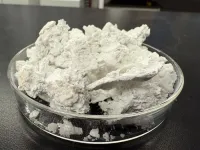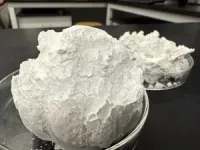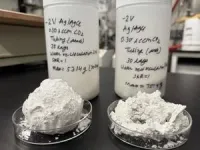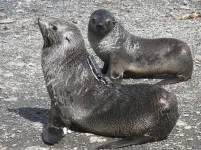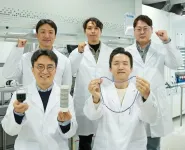Using seawater, electricity and carbon dioxide (CO2), Northwestern University scientists have developed a new carbon-negative building material.
As Earth’s climate continues to warm, researchers around the globe are exploring ways to capture CO2 from the air and store it deep underground. While this approach has multiple climate benefits, it does not maximize the value of the enormous amounts of atmospheric CO2.
Now, Northwestern’s new strategy addresses this challenge by locking away CO2 permanently and turning it into valuable materials, which can be used to manufacture concrete, cement, plaster and paint. The process to generate the carbon-negative materials also releases hydrogen gas — a clean fuel with various applications, including transportation.
The study will be published on March 19 in the journal Advanced Sustainable Systems.
“We have developed a new approach that allows us to use seawater to create carbon-negative construction materials,” said Northwestern’s Alessandro Rotta Loria, who led the study. “Cement, concrete, paint and plasters are customarily composed of or derived from calcium- and magnesium-based minerals, which are often sourced from aggregates –– what we call sand. Currently, sand is sourced through mining from mountains, riverbeds, coasts and the ocean floor. In collaboration with Cemex, we have devised an alternative approach to source sand — not by digging into the Earth but by harnessing electricity and CO2 to grow sand-like materials in seawater.”
Rotta Loria is the Louis Berger Assistant Professor of Civil and Environmental Engineering at Northwestern’s McCormick School of Engineering. Jeffrey Lopez, an assistant professor of chemical and biological engineering at McCormick, served as a key coauthor on the study. Co-advised by Rotta Loria and Lopez, other Northwestern contributors include Nishu Devi, a postdoctoral fellow and lead author; Xiaohui Gong and Daiki Shoji, Ph.D. students; and Amy Wagner, former graduate student. The study also benefited from the contributions of key representatives from the Global R&D department of Cemex, a global building materials company dedicated to sustainable construction. This work is part of a broader collaboration between Northwestern and Cemex.
Seashell-inspired science
The new study builds on previous work from Rotta Loria’s lab to store CO2 long term in concrete and to electrify seawater to cement marine soils. Now, he leverages insights from those two projects by injecting CO2while applying electricity to seawater in the lab.
“Our research group tries to harness electricity to innovate construction and industrial processes,” Rotta Loria said. “We also like to use seawater because it’s a naturally abundant resource. It’s not scarce like fresh water.”
To generate the carbon-negative material, the researchers started by inserting electrodes into seawater and applying an electric current. The low electrical current split water molecules into hydrogen gas and hydroxide ions. While leaving the electric current on, the researchers bubbled CO2 gas through seawater. This process changed the chemical composition of the water, increasing the concentration of bicarbonate ions.
Finally, the hydroxide ions and bicarbonate ions reacted with other dissolved ions, such as calcium and magnesium, that occur naturally in seawater. The reaction produced solid minerals, including calcium carbonate and magnesium hydroxide. Calcium carbonate directly acts as a carbon sink, while magnesium hydroxide sequesters carbon through further interactions with CO2.
Rotta Loria likens the process to the technique coral and mollusks use to form their shells, which harnesses metabolic energy to convert dissolved ions into calcium carbonate. But, instead of metabolic energy, the researchers applied electrical energy to initiate the process and boosted mineralization with the injection of CO2.
Dual discoveries
Through experimentation, the researchers made two significant discoveries. Not only could they grow these minerals into sand, but they also were able to change the composition of these materials by controlling experimental factors, including the voltage and current of electricity, the flow rate, timing and duration of CO2injection, and the flow rate, timing and duration of seawater recirculation in the reactor.
Depending on the conditions, the resulting substances are flakier and more porous or denser and harder — but always primarily composed of calcium carbonate and/or magnesium hydroxide. Researchers can grow the materials around an electrode or directly in solution.
“We showed that when we generate these materials, we can fully control their properties, such as the chemical composition, size, shape and porosity,” Rotta Loria said. “That gives us some flexibility to develop materials suited to different applications.”
These materials could be used in concrete as a substitute for sand and/or gravel — a crucial ingredient that accounts for 60-70% of this ubiquitous building material. Or they could be used to manufacture cement, plaster and paint — all essential finishes in the built environment.
Storing carbon in structures
Depending on the ratio of minerals, the material can hold over half its weight in CO2. With a composition of half calcium carbonate and half magnesium hydroxide, for example, 1 metric ton of the material has the capacity to store over one-half a metric ton of CO2. Rotta Loria also says the material — if used to replace sand or powder — would not weaken the strength of concrete or cement.
Rotta Loria envisions industry could apply the technique in highly scalable, modular reactors — not directly into the ocean — to avoid disturbing ecosystems and sea life.
“This approach would enable full control of the chemistry of the water sources and water effluent, which would be reinjected into open seawater only after adequate treatment and environmental verifications,” he said.
Responsible for 8% of global CO2 emissions, the cement industry is the world’s fourth-largest carbon emitter, according to the World Economic Forum. When combined with concrete production, this figure is even higher. Rotta Loria foresees putting some of that CO2 back into concrete and cement to make more sustainable materials for construction and manufacturing.
“We could create a circularity where we sequester CO2 right at the source,” Rotta Loria said. “And, if the concrete and cement plants are located on shorelines, we could use the ocean right next to them to feed dedicated reactors where CO2 is transformed through clean electricity into materials that can be used for myriad applications in the construction industry. Then, those materials would truly become carbon sinks.”
The study, “Electrodeposition of carbon-trapping minerals in seawater for variable electrochemical potentials and carbon dioxide injections,” was supported by Cemex and Northwestern’s McCormick School of Engineering.
END
